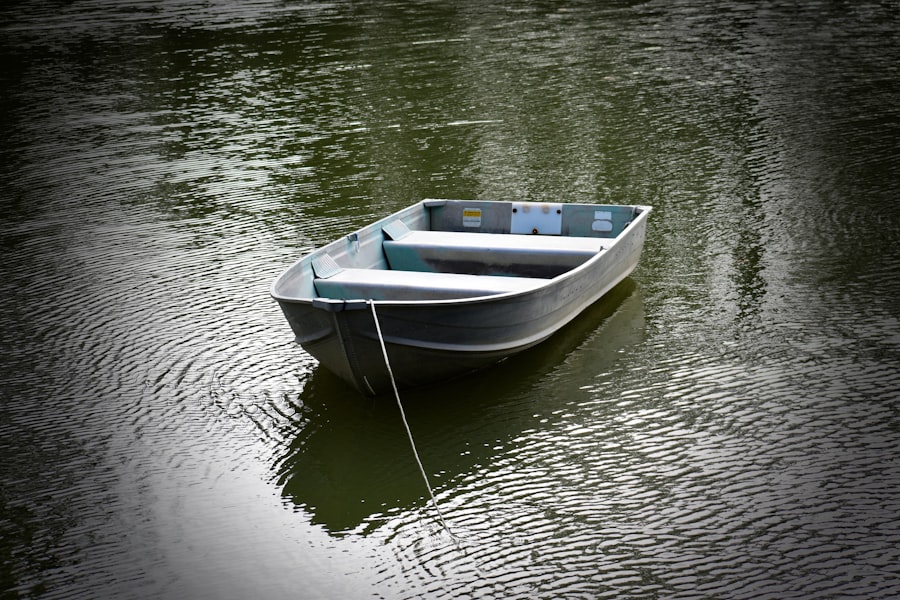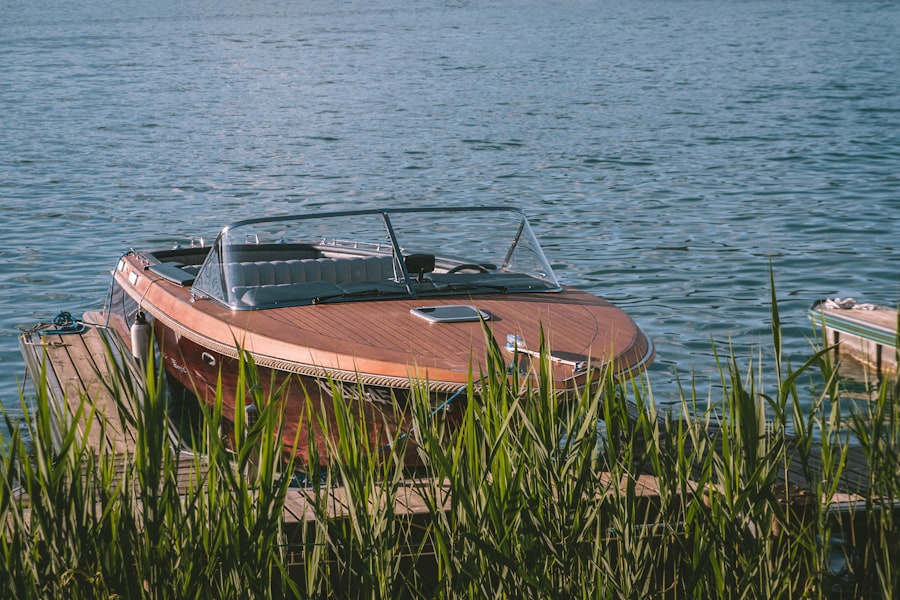Owning a row boat offers a multitude of benefits that extend beyond mere recreation. One of the most significant advantages is the opportunity for physical exercise. Rowing is a full-body workout that engages various muscle groups, including the arms, back, and core.
This low-impact activity not only helps improve cardiovascular health but also enhances muscle tone and endurance. Regular rowing can lead to increased stamina and overall fitness, making it an excellent choice for those looking to stay active while enjoying the great outdoors. In addition to physical benefits, row boating provides a unique way to connect with nature.
Gliding across a serene lake or river allows individuals to experience the tranquility of their surroundings in a way that motorized boats cannot replicate. The quietness of rowing encourages mindfulness and offers a chance to escape the hustle and bustle of daily life. Whether it’s the gentle lapping of water against the hull or the rustle of leaves in the breeze, these sensory experiences can be incredibly soothing, promoting mental well-being and reducing stress levels.
Key Takeaways
- Owning a row boat offers relaxation, exercise, and access to nature.
- Selecting the right row boat depends on your needs, size, and intended use.
- Regular maintenance ensures your row boat remains safe and functional.
- Row boats can be purchased from specialty dealers, online marketplaces, and local sellers.
- Learning proper rowing techniques and safety measures enhances your experience on the water.
Choosing the Right Row Boat for You
Selecting the right row boat is crucial to ensuring an enjoyable experience on the water. There are various types of row boats available, each designed for specific purposes and environments. For instance, if you plan to use your boat primarily on calm lakes or slow-moving rivers, a lightweight dinghy or a flat-bottomed skiff may be ideal.
These boats are easy to maneuver and can be transported with relative ease. Conversely, if you’re interested in tackling rougher waters or longer distances, a heavier, more stable row boat with a deeper hull may be necessary to provide better handling and safety. When choosing a row boat, consider factors such as size, weight capacity, and material.
A larger boat can accommodate more passengers or gear but may be more challenging to transport and store. Additionally, materials like wood, fiberglass, or aluminum each have their own advantages and disadvantages. Wooden boats offer aesthetic appeal and traditional craftsmanship but require more maintenance.
Fiberglass boats are durable and low-maintenance, while aluminum boats are lightweight and resistant to corrosion. Assessing your specific needs and preferences will help you make an informed decision that aligns with your intended use.
Tips for Maintaining Your Row Boat

Proper maintenance is essential for ensuring the longevity and performance of your row boat. Regular cleaning is one of the simplest yet most effective ways to keep your boat in good condition. After each outing, rinse off any dirt, algae, or saltwater that may have accumulated on the hull.
For wooden boats, it’s particularly important to dry them thoroughly to prevent rot and warping. Applying a protective sealant or varnish can also help preserve the wood’s integrity and enhance its appearance. In addition to cleaning, routine inspections are vital for identifying potential issues before they escalate.
Check for signs of wear and tear, such as cracks in the hull or loose fittings. Pay special attention to the oars and any rigging components, ensuring they are in good working order. If you notice any damage, address it promptly to avoid compromising safety on the water.
Seasonal maintenance tasks, such as checking for leaks or applying anti-fouling paint, should also be part of your upkeep routine to ensure your row boat remains safe and functional.
Where to Find Row Boats for Sale
| Source | Type of Row Boats Available | Price Range | Location | Additional Notes |
|---|---|---|---|---|
| Local Boat Dealers | New and Used Row Boats | 500 – 3000 | Various Cities | Offers warranty on new boats |
| Online Marketplaces (e.g., Craigslist, eBay) | Used Row Boats | 200 – 1500 | Nationwide | Prices vary; inspect before purchase |
| Boat Shows | New Row Boats | 1000 – 4000 | Seasonal, Various Locations | Opportunity to compare models |
| Specialty Row Boat Manufacturers | Custom and Standard Models | 1500 – 5000 | Regional | Customizable options available |
| Classified Ads in Local Newspapers | Used Row Boats | 300 – 1200 | Local | May find good deals from private sellers |
Finding the perfect row boat can be an exciting adventure in itself. There are numerous avenues to explore when searching for row boats for sale. Local marinas often have bulletin boards where individuals can post listings for used boats, making them a great resource for finding affordable options within your community.
Additionally, online marketplaces such as Craigslist or Facebook Marketplace frequently feature listings from private sellers looking to part with their boats. For those interested in purchasing new row boats, specialized retailers and boating supply stores offer a wide selection of models from various manufacturers. Visiting boat shows can also provide an opportunity to see different types of row boats up close and speak with knowledgeable sales representatives who can guide you through the selection process.
Furthermore, online retailers have expanded their offerings significantly, allowing you to browse an extensive range of options from the comfort of your home.
The Best Places to Take Your Row Boat
Once you’ve acquired your row boat, the next step is determining where to take it for an enjoyable outing. Many lakes and rivers across the country provide ideal settings for rowing enthusiasts. For instance, Lake Tahoe in California offers stunning views and crystal-clear waters that are perfect for leisurely rowing excursions.
Similarly, the calm waters of the Chesapeake Bay provide ample opportunities for exploration while enjoying the natural beauty of the surrounding landscape. In addition to lakes and rivers, coastal areas can also be excellent destinations for row boating adventures. The gentle waves along beaches can create a unique experience as you navigate through tidal waters.
However, it’s essential to choose locations that are suitable for your skill level and the type of row boat you own. Researching local regulations regarding boating permits and safety requirements is also crucial before heading out on your adventure.
Safety Precautions for Rowing

Safety should always be a top priority when engaging in any water activity, including rowing. Before embarking on your journey, ensure that you have all necessary safety equipment on board. This includes life jackets for each passenger, which should be properly fitted and easily accessible.
It’s also wise to carry a whistle or other signaling device in case of emergencies, as well as a first aid kit stocked with essential supplies. Understanding weather conditions is another critical aspect of safe rowing. Always check forecasts before heading out; sudden changes in weather can create hazardous conditions on the water.
If you’re rowing in unfamiliar areas, familiarize yourself with local currents and tides that could affect your journey. Additionally, it’s advisable to inform someone on land about your plans and expected return time so they can alert authorities if you do not return as scheduled.
Rowing Techniques for Beginners
For those new to rowing, mastering basic techniques is essential for both efficiency and enjoyment on the water. One fundamental aspect is learning how to hold the oars correctly; grip them firmly but not too tightly to avoid fatigue. Positioning your hands shoulder-width apart allows for better control during strokes.
As you begin rowing, focus on using your legs to drive the motion rather than relying solely on your arms; this technique will help you maintain stamina over longer distances. Another important technique is developing a consistent stroke rhythm. A smooth, steady cadence will not only make rowing easier but also enhance your overall speed and efficiency on the water.
Practice coordinating your movements by pushing off with your legs while pulling back with your arms simultaneously; this will create a fluid motion that maximizes power output with minimal effort. As you gain confidence, experiment with different stroke lengths and cadences to find what feels most comfortable for you.
Joining a Rowing Community
Becoming part of a rowing community can significantly enhance your experience as a rower while providing opportunities for social interaction and skill development. Many local clubs offer programs for beginners that include lessons on technique, safety, and maintenance. Joining such organizations not only allows you to learn from experienced rowers but also fosters camaraderie among fellow enthusiasts who share similar interests.
Participating in group outings or races can further enrich your rowing journey by exposing you to new challenges and experiences on the water. Many communities host events that cater to various skill levels, providing an excellent platform for personal growth while enjoying friendly competition. Engaging with others who share your passion can lead to lasting friendships and create a supportive network that encourages continued learning and exploration within the world of rowing.


